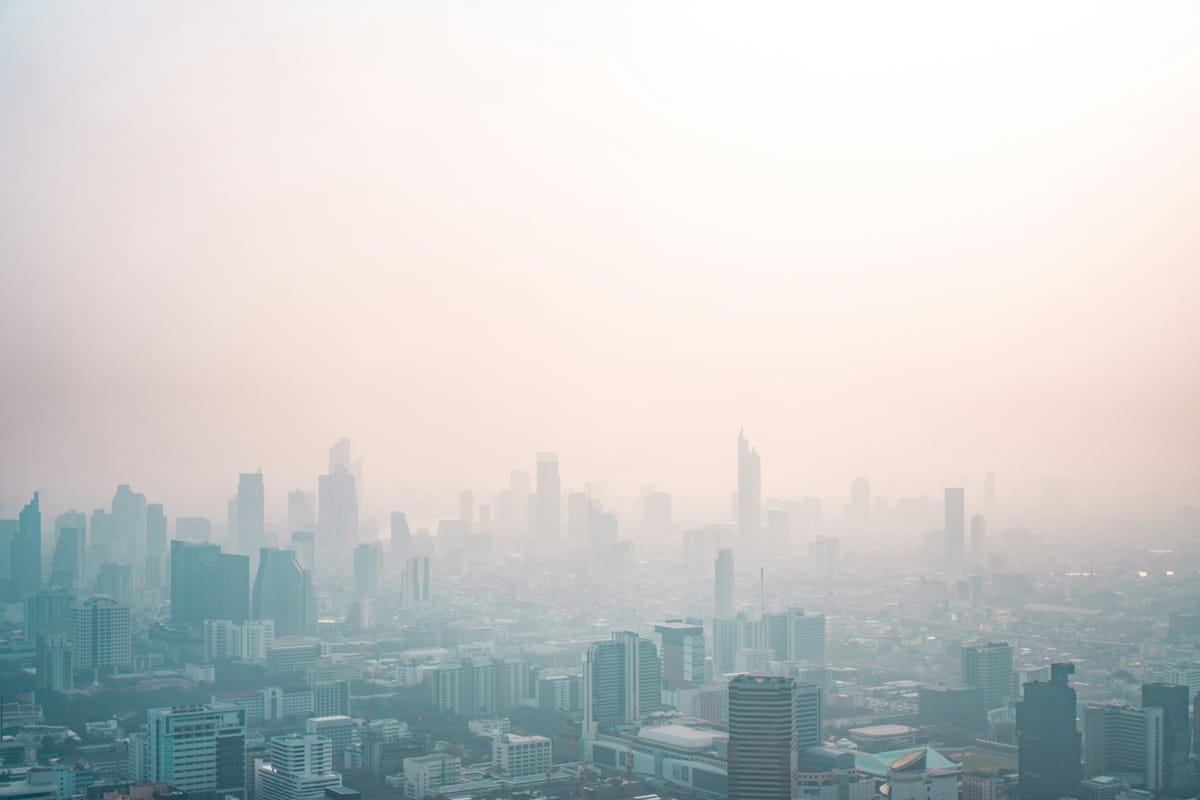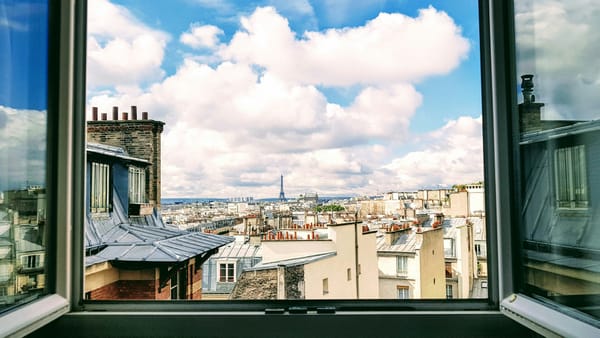How to measure and improve air quality
If you're worried about air pollution and want to protect yourself from the harmful consequences, here's what you can do

Air pollution is one of the biggest problems we face in our modern world. Emissions from factories, traffic, from the way we heat our homes get into the air and into our lungs, causing health problems in the long run.
Fine dust exposure can lead to respiratory issues and makes life harder for people with existing conditions such as asthma or chronic obstructive pulmonary disease (COPD). Dust particles can be so small they get into our lungs and into the bloodstream.
Researchers have found an association with increased risks of heart attack, stroke and hypertension. The chances of getting diseases like Alzheimer's and Parkinson's are also higher.
A lot of people are not aware of it. I wasn't for most of my life. But the problem is increasing and society as a whole needs to do something about it.
Until that happens, here's what you can do.
Step 1: Measure the air quality at home
There are many devices on the market that let you measure air quality.
Most people are aware of devices that filter the air. Air purifiers have become known during the COVID pandemic for their potential to filter out viruses from the air. But they also work for fine dust. Especially well for that. Now, if you're not interested at all in knowing what's inside the air at home, and you just want the peace of mind of clean air, you could get away with just getting an air purifier and turning it on at home. These devices sometimes come with a sensor and display that shows you which particles it filters.
These devices are obviously not as accurate as a dedicated air quality measuring device. But they give you an idea.
If you really don't want to deal with it, just get an air purifier and turn it on.
If you want to know what's inside your air in more detail, you can get in air quality meter.
Which air quality meter to get
... is influenced by how much detail you're interested in. If you just want to know whether you should open your windows or not, you can just get a CO2 meter, which will show you the carbon dioxide levels in the air. If it's above 1000 ppm (parts per million), you know you need to open your windows to get some fresh air, because it actually influences your performance and the ability of your brain to work at a high level. If you have CO2 levels above 1000 ppm or even 1500 ppm, you tend to feel sluggish, maybe get a bit of a headache, and cannot work with full cognitive ability, because you just don't have enough oxygen in the room.
If you just want to have a quick glance at air pollutants, you might get away with having an air quality meter that shows you the fine dust particles and the CO2 levels. Most cheap ones that you can get for 20 to 40 bucks at IKEA or Amazon let you do that.
Then there are devices that go into much more detail. They're more expensive, but they have built-in sensors that can provide you with a lot of very interesting data.
This is just an incomplete overview of products that are out there.
Swiss company IQAir sells different air quality meters. Some for indoors, some for the outdoors. You could get a device that you can attach to the outside wall of your home, and you can get one for the inside.
German company air-Q sells a device with the same name. It comes with different sensors: The light version gives you info about CO2, VOC (volatile organic compounds), temperature, noise, humidity and dew point.
The basic version also has sensors that measure fine dust, carbon monoxide and air pressure.
The pro version can also measure ozone, formaldehyde and nitrogen dioxide.
The science version comes with sensors for oxygen, ammonia, methane, hydrogen, hydrogen sulfide and more.
For most people the basic version will do the trick. But if you're in a lab setting, or you want to nerd out and want to know a lot more, one of the other versions might be for you. In most cases you can interact with these devices via an app that the manufacturer provides or a web app that you can log into.
Step 2: Filter the air in your home
It's common practice to open the windows three times a day to let the depleted air out and fresh air in. How does an air purifier play into this? An air purifier works by sucking in the air in the room it is positioned in and pressing that air through one or several filters. In a lot of cases, there are HEPA filters and carbon filters that bind fine dust particles and other pollutants such as bacteria, viruses, organic compounds and more. It then pushes the filtered air out of the device and thus improves the air quality of your room. There are air purifiers that work with.
Which air purifiers to avoid
It is important to avoid purchasing air purifiers that utilize ozone or ionizers. Ozone can contaminate the air and lead to the presence of other harmful substances. Other devices ionize the air, but this process is not effective in neutralizing viruses. Furthermore, the ionization of air can result in the production of ozone, which some appliances do not convert into safer compounds. The presence of ozone can cause negative health effects such as watery eyes, respiratory issues, and headaches. Air purifiers that use UV-C light should also be approached with caution. While UV radiation has the potential to neutralize viruses, it is unclear whether commercially available devices effectively deactivate viruses. If using UV-C air purifiers, it is important to ensure that they do not emit any UV-C radiation to protect the skin and eyes.
How to air
The best case would be if you open the windows, fresh air comes in, and you see the air quality in your room improving. CO2 levels go down, oxygen goes up. But what if you live in a city where air pollution is prevalent?
In my case, I sometimes get fresh air when I open my window. Especially when it's not a cloudy day. But since I live in a city, more often than not, when I open the window, pretty bad air comes in.
So why bother opening the windows anyway? Because we need oxygen, and we need to prevent mold. Some compounds just don't go away by themselves. You need the mixing through of air.
So what can you do? After you've opened the window, on the dashboard of your air quality meter you see that some aspects of your air have improved. But you see that other parameters have worsened. If you have a device that shows you a health index, you might see red numbers. You get a little nervous. Well, you should because the air is bad now, maybe worse than it was before. Even if you have the feeling that you can breathe better because there's more available oxygen.
Now is the time to put your air purifier on turbo mode and have it clean the air that you just let in. After 5–15 minutes, you should be fine. You could do that three times a day.
If you live in a rural area where you have a lot of fresh air or nature nearby, you might not even need an air purifier. But in my case, living in a city where people still have ovens to heat their apartments and there is lots of traffic, I actually need an air purifier to keep a good air quality in my home.
A note on city apartments
An important aspect to keep in mind is that most apartments were not built with the idea of people living in them all day. Unless you live in a modern new build with ventilation system and other advanced technologies.
That means most apartments were built for people not being at home all day because they are at work. This changed during COVID. People started working from home, sometimes spending the whole day inside.
Writing that sounds weird when you think about it. People are supposed to live in their home, right? But from an air quality perspective, it does make a difference if you deplete the air all day long versus just being at home in the evening and at night.
Even if you open the windows three times a day: When the whole family is at home all day, the air is depleted more quickly than if you just gather in the evening.
Step 3: Get an overview of the air quality when you're out and about
There are several apps that let you see the air quality of the location you're in. Some cities provide a local app. The best website that I've found and that I use on a daily basis together with my air quality meter is the website of IQAir. It gives you an air quality index of basically every major city in the world.
Areas that aren't covered with actual measuring stations get an index value that is based on predictive satellite data. IQAir pulls in data by government measuring stations and device data of their users (crowdsourced).
That gives you an overview if you're traveling, if you're in a new city, or you're just in your hometown but obviously don't have your air quality meter device with you because it's at home.
Step 4: Protect yourself while you're outside
If I see that the air quality is bad in whatever place I happen to be in, I tend to do one of the following.
If the air quality is terrible and if it's possible, I stay inside. Why not take a day off and stay at home or work from home. Filter your air, if possible, get a good home workout in and do step exercises in front of your favorite Netflix show, and just enjoy the time at home.
If I have to or want to go outside because I have to go to work or if I'm traveling and don't want to be stuck in my hotel room, I always bring FFP2 masks with me. The same that we all had to wear during COVID.
Living in a European country, it's still a bit frowned upon by some people as they still associate that with COVID. Remember, there were a lot of people that were against masks and the government trying to tell you that there's a virus. But in other countries, especially in Asian countries, wearing a mask outside because of smog and air pollution is as normal as having a coffee in the morning.
I go outside with a mask and go about my day. What I don't do is sports outside when the air quality is bad. Sometimes I ride my bike to work, and I feel like if I have a relaxed pace, I can do that with a mask. But jogging or other forms of sport with a mask are really exhausting and can increase blood pressure. [1]
Doing sports without a mask when the air is polluted is also not a good idea because the fine dust particles get into your lungs, especially when you're doing vigorous exercise.
What works really well is going for a walk. If it's a beautiful day and I feel like a home workout or two are not enough or if I just need to go about my day because of work or grocery shopping, I wear a mask and go for a walk. It's healthy, steady state, moderate movement that gets the body moving, which is very easily doable with a mask without straining yourself.
Fine dust is not to be underestimated.
If you think that you can just close your windows and be fine, you're wrong. I didn't believe it until I had my air quality meter.
Measurements show[2], not only my own but by actual environmental organizations[3], that during New Year's Eve, the fine dust pollution has the highest peak in all the year. Also, the day after.
It gets so intense that fine dust actually goes through windows. Now you might say, well, glass is solid. How can it pass through windows? It's not necessarily that fine dust goes through glass, but rather through the window frame and past the seal.
On an event like New Year's Eve, I keep my windows closed and my air purifier on all night in order to avoid pollution inside.
It also happens on normal days when the pollution is very high.
Wrapping up
So there you have it. These are my strategies for measuring and improving air quality. Next up I'll have an article about how to act upon air quality meter data, in which I give you my strategies of going about airing my apartment, based on data.
In the third article, I'll tell you a little hack of how to prolong the life of your air purifier filters.
Stay tuned for more, and thank you for reading.



